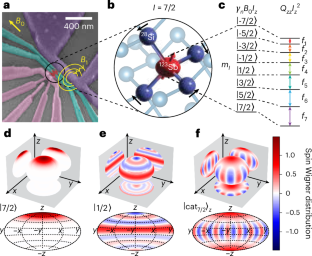UNSW researchers have achieved a significant breakthrough in quantum computing by implementing the Schrödinger’s cat thought experiment using an antimony atom, as published in Nature Physics. Led by Professor Andrea Morello, the team developed a novel approach to enhance quantum computations and error correction.
The experiment centers on using an antimony atom’s nuclear spin, which can take eight different directions, unlike traditional qubits that only have two states. This complexity creates a system analogous to Schrödinger’s famous thought experiment, where a cat exists simultaneously in multiple states. In this case, the “cat” is the antimony atom’s quantum state, existing in a superposition of multiple directions.
The key innovation lies in how this system handles errors in quantum computing. Traditional qubits are highly vulnerable to errors because a single disturbance can immediately flip a state from 0 to 1. However, the antimony-based system requires seven consecutive errors to corrupt the quantum information completely, making it significantly more robust. As Xi Yu, the lead author, explains, the system essentially gives their quantum “cat” seven lives, providing multiple layers of protection against errors.
The research team implemented this concept within a silicon quantum chip, similar to those found in conventional computers but modified to control a single atom’s quantum state. Dr. Danielle Holmes at UNSW fabricated the chip, while University of Melbourne colleagues handled the precise insertion of the antimony atom.
This implementation is particularly promising because it combines quantum robustness with scalability. The use of silicon-based technology means that existing semiconductor manufacturing methods could potentially be adapted for larger-scale production. The system allows for immediate error detection and correction before multiple errors can accumulate, addressing one of quantum computing’s major challenges.
The project represents a collaborative effort across multiple institutions. Beyond UNSW Sydney and the University of Melbourne, theoretical contributions came from Sandia National Laboratories, NASA Ames, and the University of Calgary. These partners helped develop methods for creating and measuring the complex quantum states involved.
Looking ahead, the team plans to focus on demonstrating quantum error detection and correction capabilities, considered a crucial milestone in quantum computing development. The research suggests a path toward more reliable quantum computations while maintaining the binary encoding of information (0 or 1) that underlies modern computing.
This breakthrough is significant because it offers a practical implementation of a famous thought experiment while simultaneously addressing key challenges in quantum computing reliability. By creating a system that can tolerate multiple errors before failing, the research team has potentially opened new avenues for developing more robust quantum computers. The work demonstrates how fundamental physics concepts can be transformed into practical engineering solutions for quantum computing challenges.
Reference: “Schrödinger cat states of a nuclear spin qudit in silicon” by Xi Yu, Benjamin Wilhelm, Danielle Holmes, Arjen Vaartjes, Daniel Schwienbacher, Martin Nurizzo, Anders Kringhøj, Mark R. van Blankenstein, Alexander M. Jakob, Pragati Gupta, Fay E. Hudson, Kohei M. Itoh, Riley J. Murray, Robin Blume-Kohout, Thaddeus D. Ladd, Namit Anand, Andrew S. Dzurak, Barry C. Sanders, David N. Jamieson and Andrea Morello, 14 January 2025, Nature Physics. DOI: 10.1038/s41567-024-02745-0


